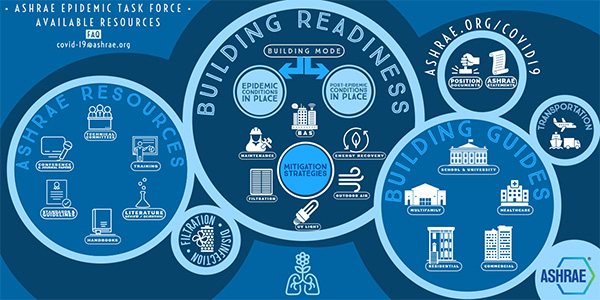
Sars-Cov-2 and Mutations: What is the Message for Hydronics?
May 18, 2021 | By Robert Bean
Unconditioned spaces can cause thermal stress to people that may be directly life-threatening and that may also lower resistance to infection.

The American Society of Heating, Refrigerating and Air-Conditioning Engineers (ASHRAE) has dedicated pages on its website with guides, technical resources and recommendations for addressing COVID-19 concerns in the built environment.
Severe acute respiratory syndrome coronavirus 2 (SARS-Cov2) is the virus responsible for starting the 2019 pandemic that continues today with no foreseeable end in sight. The virus does NOT travel independently; instead, it is a respiratory particle guest originating from the respiratory pathways’ infected areas within infected individuals. The number of particles with the virus depends on the infection location(s) (nose, throat, bronchial tubes, and alveoli) and exhalation intensity (breathing, talking, coughing, sneezing, singing, shouting). This is important for general understanding, but it has little bearing on building design and operation and HVAC systems.
As we know, COVID-19 is a disease caused by the virus resulting in short- and long-term illnesses and death. Despite the emphasis on personal and building hygiene, there remains little evidence that the virus’s spread frequently occurs from touching surfaces (fomite). That is not to suggest that one should not maintain good hygiene.
Close range inhalation of droplets and aerosols and inhalation of airborne particulates of some distance beyond the infected person(s) are the dominant transmission paths. The airborne vectors carrying the host particles with a virus is not magic; it is standard particle dispersion theory 101—that is…where the air goes – so goes the virus.
Suppose one person’s infected exhalation can become another person’s inhalation. In that case, there is a high probability of transmission if no protective measures are taken. That is why distancing and a proper mask appropriately worn indoors and, in some cases, outdoors is essential. These are two tactics in the overall strategy to reduce transmission.
Implications for the HVAC industry
Members of the international Indoor Environmental Quality General Alliance (IEQ-GA.net), including member organizations such as ASHRAE, believe there is sufficient evidence to suggest that airborne transmission cannot be ignored. David B. Resnik noted in discussing the Precautionary Principle and Medical Decision Making, “One should take reasonable measures to avoid threats that are serious and plausible.”
ASHRAE’s most current position is “ventilation and filtration provided by heating, ventilating, and air-conditioning systems can reduce the airborne concentration of SARS-CoV-2 and thus the risk of transmission through the air. Unconditioned spaces can cause thermal stress to people that may be directly life-threatening and that may also lower resistance to infection. In general, disabling of heating, ventilating, and air-conditioning systems is not a recommended measure to reduce the transmission of the virus.”
As I have said, “If satisfying a thermostat setting destroys the process of decontamination, deodorization and dehumidification of ventilation air, the HVAC system is dysfunctional.”
How many HVAC systems do you know where ventilation and filtration are disabled when the thermostat has been satisfied? Think about that for a second, given the current situation. This is one of the significant benefits of hydronic systems; they enable the separation between indoor air quality systems and thermal comfort systems.
These systems are symbiotic under the umbrella of indoor environmental quality (IEQ) but independently serve the occupants without reducing effectiveness. When trying to manage an airborne pathogen’s transmission, we do not want to allow it to hang around. It is imperative to keep the ventilation and filtration systems operating ALL the time…and that lends itself perfectly to hydronic-based systems.
My advice to readers; there is no safe definitive social distance nor exposure time. SARS-CoV2 does not come with a timer or an onboard navigational system; wherever the air goes, so goes the virus…it doesn’t know one metre from two metres from 10 metres. It doesn’t know what 10 seconds is, nor 30 seconds nor 15 minutes.
Wear proper masks properly in the presence of any uncertain risk. Personal and building hygiene is good but not a surrogate for air hygiene, resulting from appropriate ventilation and filtration. Vaccines are essential, but they are not the long-term solution to preventing transmission inside buildings. Counting on vaccines is a game of whack-a-mole. Preparing buildings and people for pandemics is a forever solution.
Public service announcement: if you must create an isolation room in your home, condo or apartment, see this link: healthyheating.com





